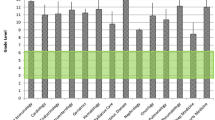Abstract
Purpose
Globally, pediatric surgical association websites present patient/family education materials on an extensive list of conditions, including descriptions of the condition, signs and symptoms, diagnostic modalities, and treatment options. The purpose of this project was to assess the readability of pediatric surgical association websites’ patient/family education materials.
Methods
With IRB approval, we accessed all patient/family education materials on pediatric surgical association websites from around the globe and used multiple grade-level assessments and readability assessments to determine the reading level at which the information is presented.
Results
The American Pediatric Surgical Association (APSA) website and the British Association of Paediatric Surgeons (BAPS) present publicly accessible patient/family education materials. Seventy-four (74) conditions on APSA’s website were analyzed. Three grade-level assessments and the Flesch Reading Ease assessment indicated that the articles are written at high school reading levels. No articles were available in languages other than English. BAPS presented 6 conditions, most of which were more readable than their APSA counterparts.
Conclusions
Our analysis indicates that the patient/family education materials available on pediatric surgical association websites may not be written at a level that is comprehensible by the general population. Potential solutions include re-writing the materials with an emphasis on readability and presenting materials in languages other than English.
Level of evidence
V.


Similar content being viewed by others
References
Eysenbach G, Kohler C (2003) What is the prevalence of health-related searches on the World Wide Web? Qualitative and quantitative analysis of search engine queries on the internet. In: AMIA annual symposium Proceedings, pp 225–229
Sepucha KR, Atlas SJ, Chang Y, Freiberg A, Malchau H, Mangla M et al (2018) Informed, patient-centered decisions associated with better health outcomes in orthopedics: prospective cohort study. Med Decis Mak 38(8):1018–1026
Williams MV, Baker DW, Parker RM, Nurss JR (1998) Relationship of functional health literacy to patients’ knowledge of their chronic disease. A study of patients with hypertension and diabetes. Arch Intern Med 158(2):166–172
Safeer RS, Keenan J (2005) Health literacy: the gap between physicians and patients. Am Fam Physician 72(3):463–468
Flesch R (1948) A new readability yardstick. J Appl Psychol 32(3):221–233
Freimuth VS (1979) Assessing the readability of health education messages. Public Health Rep 94(6):568–570
Leichter SB, Nieman JA, Moore RW, Collins P, Rhodes A (1981) Readability of self-care instructional pamphlets for diabetic patients. Diabetes Care 4(6):627–630
Hansberry DR, Agarwal N, Shah R, Schmitt PJ, Baredes S, Setzen M et al (2014) Analysis of the readability of patient education materials from surgical subspecialties. Laryngoscope 124(2):405–412
Kue J, Klemanski DL, Browning KK (2021) Evaluating readability scores of treatment summaries and cancer survivorship care plans. JCO Oncol Pract 17(10):615–621
Okuhara T, Ishikawa H, Ueno H, Okada H, Kato M, Kiuchi T (2022) Readability assessment of vaccine information: a systematic review for addressing vaccine hesitancy. Patient Educ Couns 105(2):331–338
Fowler GA, Heater B (1983) Guidelines for clinical evaluation. J Nurs Educ 22(9):402–404
Funding
None.
Author information
Authors and Affiliations
Contributions
Study conception and design: AG. Acquisition of data: LW. Analysis and interpretation of data: all authors. Drafting and revision of manuscript: all authors. All authors approved the final manuscript.
Corresponding author
Ethics declarations
Conflict of interest
The authors have no competing interests to declare.
Additional information
Publisher's Note
Springer Nature remains neutral with regard to jurisdictional claims in published maps and institutional affiliations.
Rights and permissions
Springer Nature or its licensor (e.g. a society or other partner) holds exclusive rights to this article under a publishing agreement with the author(s) or other rightsholder(s); author self-archiving of the accepted manuscript version of this article is solely governed by the terms of such publishing agreement and applicable law.
About this article
Cite this article
Willis, L., Gosain, A. Readability of patient and family education materials on pediatric surgical association websites. Pediatr Surg Int 39, 156 (2023). https://doi.org/10.1007/s00383-023-05446-6
Accepted:
Published:
DOI: https://doi.org/10.1007/s00383-023-05446-6




